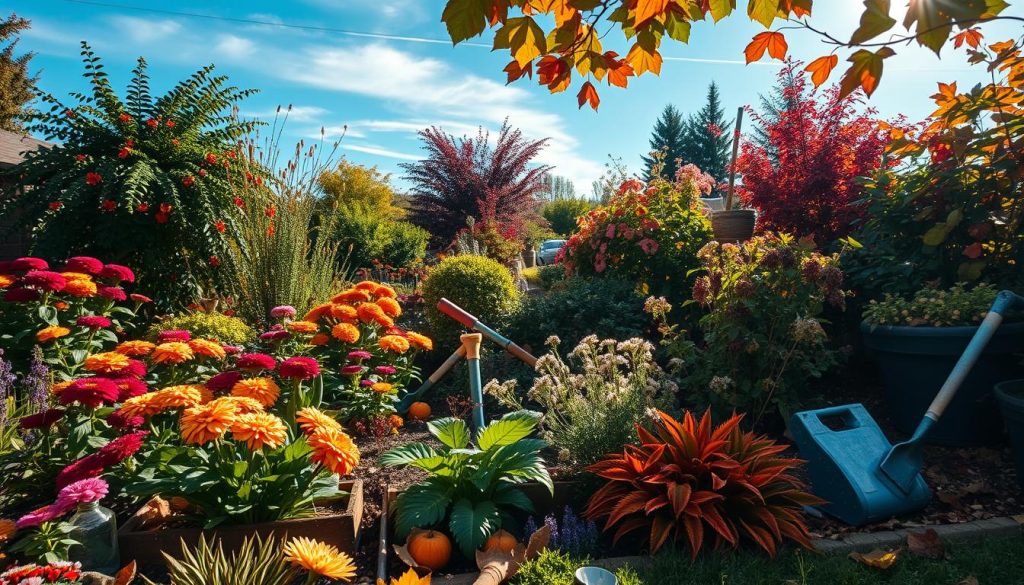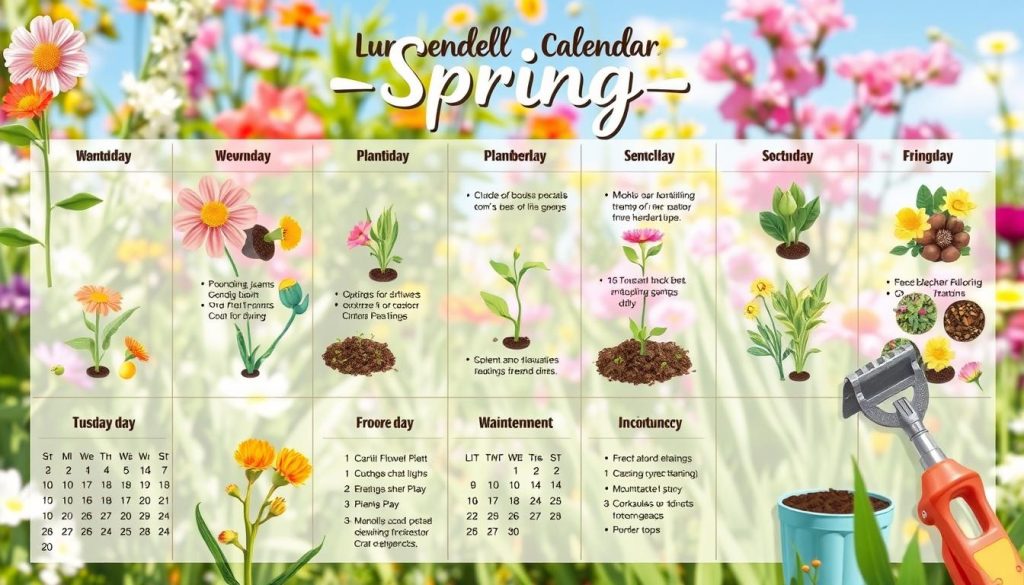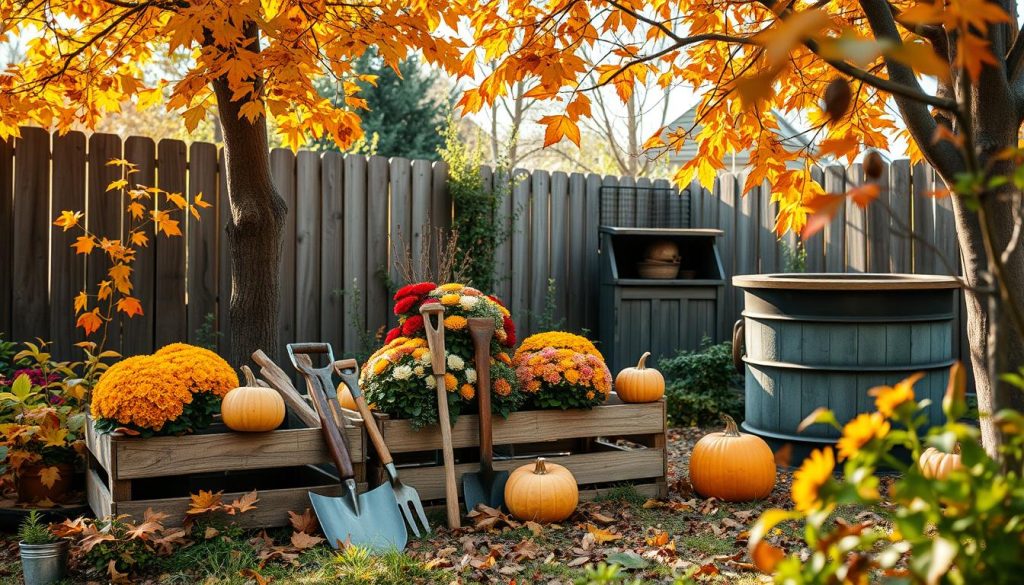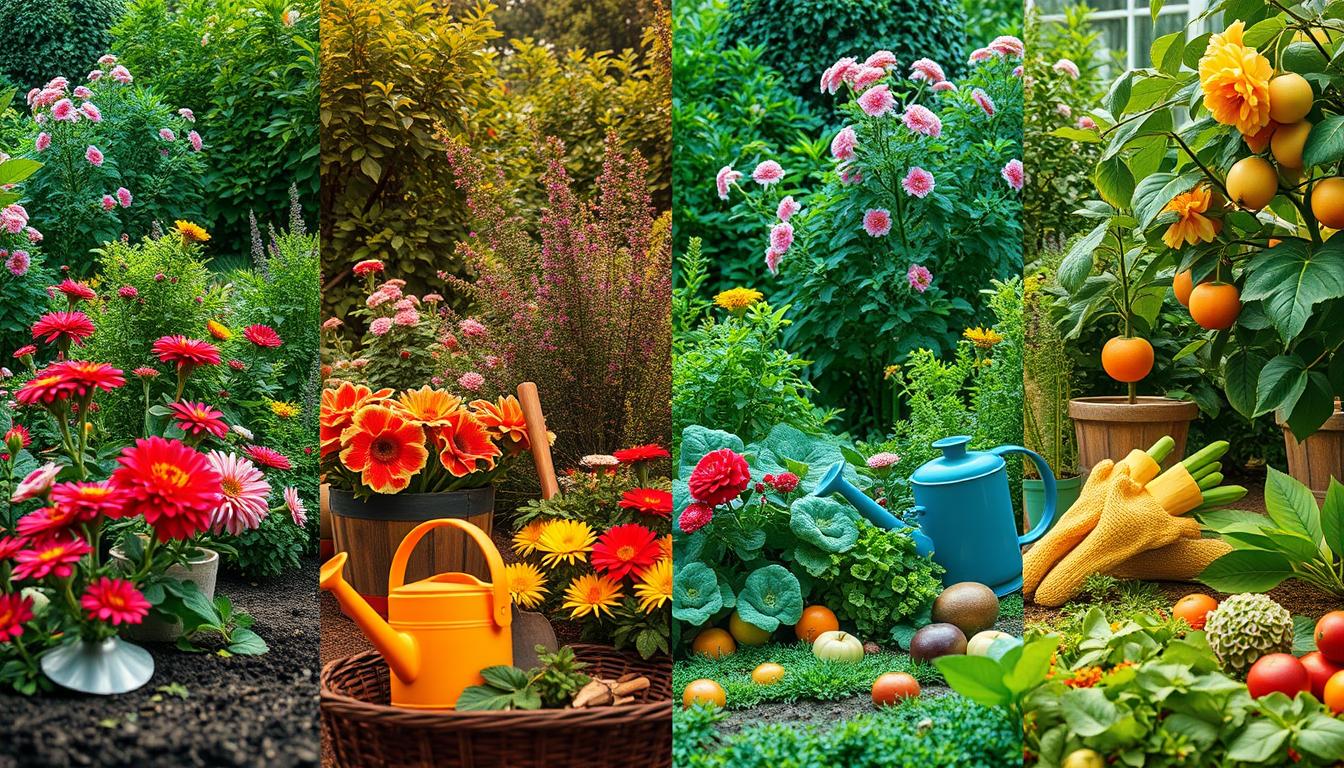As a gardener, I know how crucial a seasonal gardening checklist is. It ensures my garden flourishes all year. This checklist keeps me organized and focused on the tasks for each season.
I’ll share my detailed checklist, covering all key tasks and tips for each season. It includes spring prep to winter care. This will help you create a beautiful garden. A well-organized checklist is vital for a great gardening experience.
Whether you’re new or experienced, a seasonal gardening checklist is essential. It helps you stay on track and enjoy your gardening. It breaks down tasks by season, making them easier to manage.
Understanding Seasonal Gardening Benefits
As a gardener, I’ve learned how vital seasonal gardening is. A seasonal planting guide helps me care for my garden at the right time. This is key for its growth and survival. Seasonal garden maintenance is essential for a thriving garden, adapting to climate changes and meeting plant needs.
Some key benefits of seasonal gardening include:
- Improved plant growth and health
- Increased crop yields
- Reduced pest and disease problems
- Enhanced biodiversity
Why Seasonal Gardening Matters
Seasonal gardening connects me with nature and its growth cycles. Following a seasonal planting guide helps me plan my garden. It considers the needs of my plants in each season. This approach also makes my garden more sustainable.

Adapting to Climate Changes
Adapting to climate changes is crucial for a healthy garden. Understanding climate change’s impact helps me protect my garden. I use drought-tolerant plants, reduce water use, and shield plants from extreme weather. A seasonal planting guide and climate adaptation ensure my garden thrives all year.
Spring Gardening Preparations
As winter fades, gardeners look forward to spring. It’s a time to refresh your garden for a great year. A seasonal gardening calendar and monthly to-do list are key. They help you care for your garden at the right time.
A good seasonal gardening calendar outlines all the tasks for a healthy garden. Breaking these down into monthly tasks makes them easier to manage. Key spring tasks include:
- Cleaning up the garden, removing debris and dead plant material
- Soil testing and amendments, to ensure optimal nutrient levels and pH balance
- Choosing early season plants, such as cool-season crops and flowering bulbs
By using your seasonal gardening calendar and monthly to-do list, you’re set for a great gardening season. Be ready to adjust for weather changes or your garden’s needs.

With a good plan, gardening becomes rewarding. You’ll enjoy growing your plants and harvesting fresh produce. Start today and make this spring your best yet.
| Month | Gardening Tasks |
|---|---|
| March | Clean up the garden, start seeds indoors |
| April | Soil testing and amendments, plant cool-season crops |
| May | Choose early season plants, start warm-season crops |
Summer Gardening Tasks
When summer comes, it’s key to focus on keeping your garden healthy. You need a plan for watering, pruning, and fertilizing your plants. This plan helps your garden grow well.
Having a good plan lets you use the warm weather and long days to your advantage. It’s also smart to use deep watering and mulching. These methods save water and keep your garden moist. By following these tips, you’ll have a garden full of life and plenty to harvest.
Watering Strategies
- Water your plants deeply but infrequently to encourage deep root growth
- Use mulch to retain moisture and suppress weeds
- Avoid overwatering, which can lead to root rot and other problems

Pest Control Techniques
To keep pests away, try natural methods like introducing beneficial insects or using neem oil. Always watch your plants for signs of pests. If you see any, act fast to stop the problem.
Harvesting Early Crops
Summer is the best time to pick early crops like tomatoes, peppers, and cucumbers. Check your plants often for ripe fruits. Harvesting them quickly helps your plants keep producing. With these tips and a good plan, your summer gardening will be a success.
Fall Gardening Essentials
As summer ends, it’s time to think about fall gardening. This season is key for getting your garden ready for winter. With some important tips, your garden will stay healthy and vibrant.
First, prepare your soil for winter. Add compost or manure to make it better. Start picking fall crops like broccoli, kale, and carrots for the cooler weather. Fall is also great for planting perennials that come back every year.

- Dividing and transplanting perennials
- Adding a layer of mulch to retain moisture and suppress weeds
- Planting spring-blooming bulbs, such as tulips and daffodils
Follow these tips to keep your garden looking good in fall. Stay on top of your gardening tasks to have a healthy garden all year.
Winter Gardening Care
As winter comes, it’s key to keep your garden healthy. Protecting plants from frost is a top priority. You can use mulch, frost blankets, or move potted plants inside.
A seasonal planting guide helps pick which plants need frost protection. It also tells you when to plant new ones. With a gardening checklist, you can keep up with tasks like pruning and watering, even when it’s cold.
Protecting Plants from Frost
- Use mulch to insulate the soil and protect roots from freezing temperatures
- Cover plants with a frost blanket to prevent damage from frost and freezing rain
- Bring potted plants indoors to a warm and cozy location
Indoor Gardening Activities
Winter is great for indoor gardening. You can start seeds for spring or grow new plants from cuttings. A seasonal planting guide helps you prepare for the growing season. This way, your garden stays beautiful all year.
Tools and Supplies Checklist
To keep your garden thriving, you need the right tools and supplies. A seasonal gardening calendar and a monthly garden to-do list are key. They help you stay on track and care for your garden properly. With the right tools and supplies, your garden will be beautiful and productive all year.
Essential Gardening Tools
Some must-have tools include a trowel, pruners, and a watering can. These help with planting, pruning, and watering. Here are more tools to think about:
- Gloves to protect your hands from thorns and dirt
- A rake to remove debris and leaves
- A hoe to cultivate the soil
Recommended Planting Supplies
You’ll also need quality planting supplies. This includes seeds, fertilizers, and mulch. These supplies help create a healthy garden. Your garden will give you fresh produce and beautiful flowers for months.
Having a seasonal gardening calendar and a monthly garden to-do list is crucial. They help you organize and prepare for gardening. Gardening offers physical exercise, mental relaxation, and a sense of accomplishment.
Seasonal Plant Care Tips
To keep your garden thriving, it’s essential to provide the right care for your plants. A well-planned seasonal plant care schedule can make all the difference. By following a few simple seasonal garden care tips, you can ensure your plants receive the right care at the right time.
A key part of any seasonal plant care schedule is fertilizing. Fertilizing schedules should be tailored to the specific needs of your plants. For example, plants that bloom in the spring may require a fertilizer high in phosphorus, while plants that produce fruit or vegetables may require a fertilizer high in potassium.
Fertilizing Schedules
- Spring: Fertilize plants with a balanced fertilizer (10-10-10) to promote healthy growth.
- Summer: Fertilize plants with a fertilizer high in phosphorus (15-30-15) to promote blooming.
- Fall: Fertilize plants with a fertilizer high in potassium (10-10-20) to promote root growth.
Pruning Techniques
Pruning is another crucial aspect of seasonal plant care. Pruning techniques can vary depending on the type of plant and the time of year. For example, pruning in the spring can help promote healthy growth, while pruning in the fall can help prepare plants for the winter months.
By following these seasonal garden care tips and creating a seasonal plant care schedule, you can keep your garden thriving all year round. Remember to tailor your care to the specific needs of your plants, and don’t be afraid to experiment and try new things.
| Season | Fertilizer | Pruning |
|---|---|---|
| Spring | 10-10-10 | Promote healthy growth |
| Summer | 15-30-15 | Promote blooming |
| Fall | 10-10-20 | Promote root growth |
Designing a Year-Round Garden
To make your garden grow all year, use seasonal tips and tricks. This way, your garden gets the care it needs to thrive. Think about the good of planting friends together and changing up your crops.
Planting friends means pairing plants that help each other grow. For example, marigolds keep nematodes away from tomatoes. Beans help corn stand tall. This makes your garden strong and diverse.
Companion Planting Ideas
- Planting marigolds with tomatoes to deter nematodes
- Planting beans with corn to provide structural support
- Planting basil with lettuce to improve flavor and texture
Crop Rotation Benefits
Changing up your crops is key to a year-round garden. It keeps the soil rich, fights pests, and helps plants grow well. Switching between greens, roots, and fruits balances the soil.
Use these tips to make your garden strong and lively all year. Keep an eye out for more gardening advice to reach your goals.
Troubleshooting Common Issues
As a gardener, I’ve learned that even with the best care, problems can still happen. It’s key to spot and fix issues quickly to keep your garden healthy.
Identifying Plant Diseases
Plant diseases can harm your garden. Look out for powdery mildew, leaf spot, and root rot. Signs include yellow leaves, black spots, or soft stems.
Regular checks on your plants can help stop diseases from spreading.
Addressing Pest Problems
Pests can damage your garden too. Aphids, whiteflies, and slugs are common culprits. To fight pests, try introducing beneficial insects, organic pesticides, and removing weeds.
By following a seasonal planting guide and keeping up with garden care, you can lower pest risks.
Here are some tips for fixing common garden problems:
- Regularly inspect your plants for disease or pests
- Use a mix of methods to solve problems
- Keep a gardening journal to track your progress and find patterns
Reflecting on the Gardening Year
As the gardening season ends, it’s time to think about what went right and plan for next year. Use a seasonal gardening calendar and a monthly garden to-do list to stay organized. This way, your garden will get the care it needs all year.
Start by looking at what did well in your garden this season. Note the plants and methods that made your garden healthy and vibrant. This info will help you plan your garden layout and planting schedule for next year.
Then, think about any challenges you faced, like pests or bad weather. Write down how you can solve these problems, like using new plants or changing your watering schedule. By tackling these issues, you can make your garden even better next year.
Now, think about new ideas for your garden. Look at gardening magazines, go to local nursery events, or check online forums. You might find new plants or gardening methods that fit your garden. With some planning and a positive outlook, you can have a thriving garden every year.

